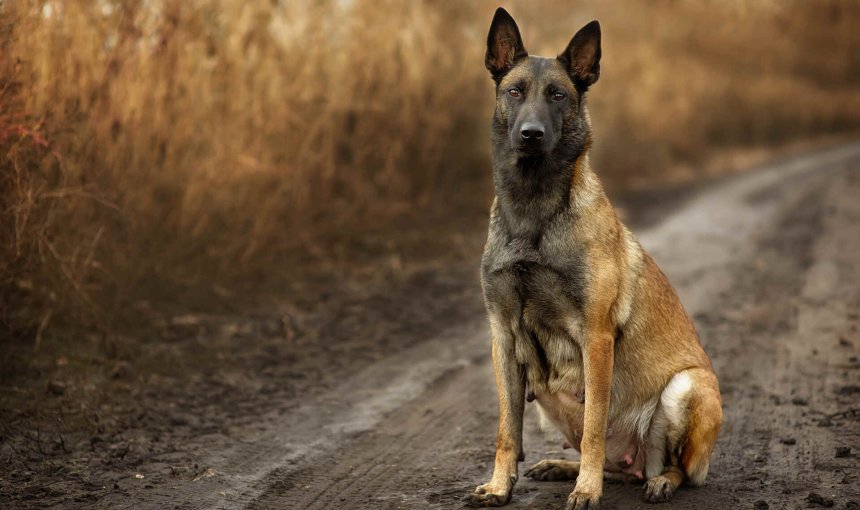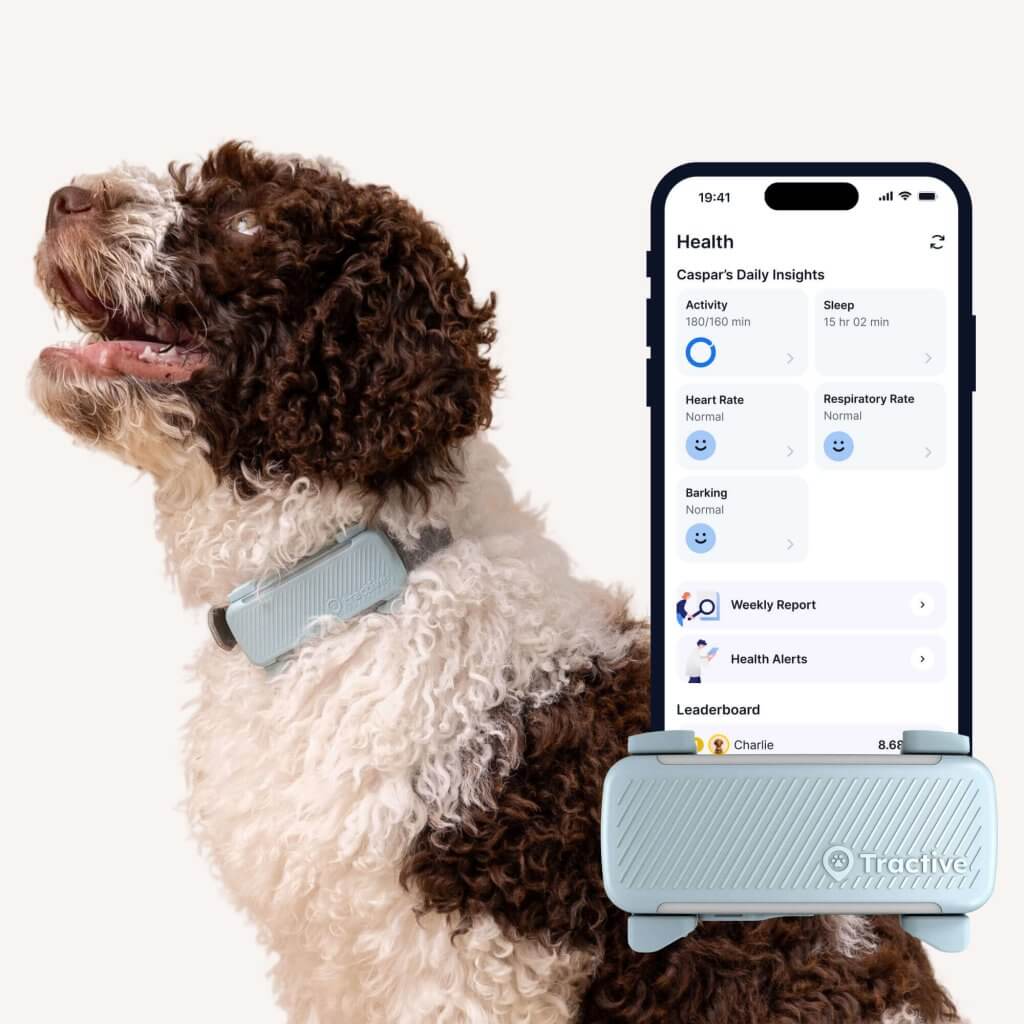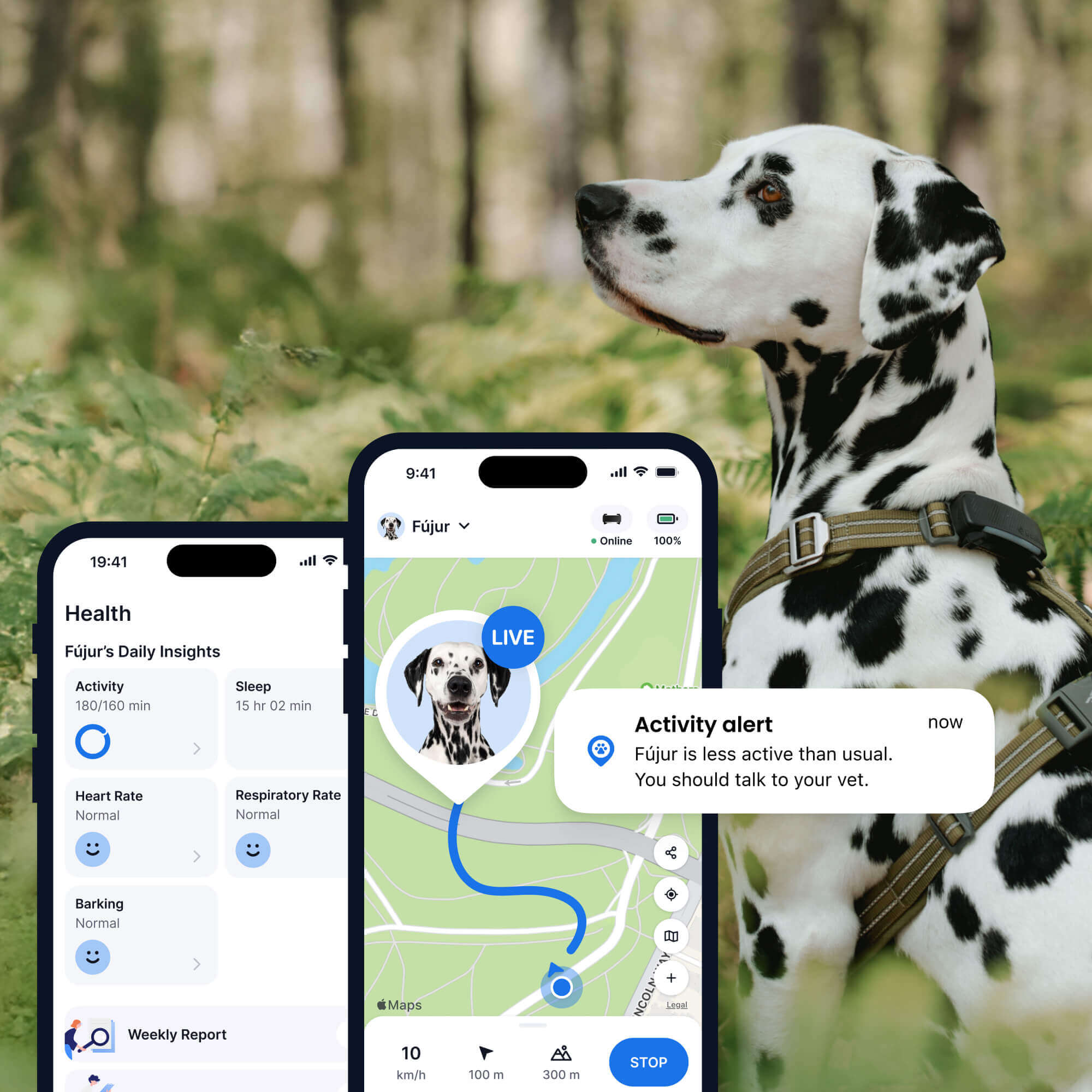How Do I Know If My Dog Is Pregnant? 8 Major Signs
Got an intact girl dog at home that's been sniffing around boy dogs lately? Wondering, is my dog pregnant? Here are 8 signs to watch out for - so you know what to expect when your dog's expecting.

Whether it’s your first time navigating the journey to puppy grandparent-hood or you’re just hoping to catch the early signs – you wouldn’t be the first to wonder, how do I know if my dog is pregnant? Turns out, having an intact girl dog spending time outdoors could mean a litter of puppies within a couple of months! Here are 8 telltale signs of dog pregnancy and how a drop in your dog’s activity can be an early indicator.

Always know your buddy is healthy & safe
Read more- 8 signs my dog is pregnant: What should I look for?
- How to know if my dog is pregnant – from a vet visit
- So my dog is pregnant. How do I care for her?
- What should I do once my dog starts giving birth?
- Red flags that signal an emergency vet visit
- How to care for newborn puppies
- How a smart dog tracker can help
8 signs my dog is pregnant: What should I look for?
While the exact duration can depend on your dog’s breed and other factors, most dogs tend to be pregnant for around 62-64 days on average. Here are a few key symptoms to keep an eye out for:
- A change in appetite.
Some dogs lose interest in food in the early weeks, while others might start eating more. - Vomiting
Much like morning sickness in humans, a pregnant dog might vomit in the first few weeks. Make sure to watch out for any other concerning signs, like diarrhea. (Which could indicate a stomach bug instead.) - Peeing more frequently than usual,
- Weight gain
Monitoring your dog’s weight can help you pick up early on the signs of pregnancy. A dog BMI calculator can help you get an idea of a healthy weight range. - Enlarged abdomen
A more obvious sign, especially a few weeks into the pregnancy, is a slightly enlarged belly. This change will become more noticeable as the pregnancy progresses. - Swollen nipples
These might become more prominent, darker, or even secrete a bit of milky fluid. - Behavioral changes
Pregnant dogs may become more affectionate, seeking out cuddles. Others might become more withdrawn. You may also notice nesting behaviors, where your dog starts gathering soft items like blankets or toys to create a comfortable space. These changes are all part of your dog’s natural instinct to care for her future puppies. - Tiredness or lethargy
You might notice that your dog seems less energetic. If they’re usually a whirlwind of energy but suddenly prefer long naps, it could be an early sign they’re pregnant.

Get health alerts for your dog
Our pups can’t always tell us if something’s wrong. But if their tracker detects unusual changes in their routine, you’ll get an alert, helping you catch potential issues early.
How to know if my dog is pregnant – from a vet visit
If you suspect that your dog is pregnant, it’s always a good idea to get a vet’s confirmation sooner rather than later. Here’s what to expect during the process:
- Physical examination. In the early stages, your vet might palpate your dog’s abdomen to feel for signs of pregnancy. This can sometimes detect puppies from around 28 days.
- Ultrasound or X-Ray. By the time your dog reaches about 3-4 weeks, an ultrasound can confirm pregnancy. Later on, your vet can even count the number of puppies via an X-ray!
- Advice on nutrition and care. Your vet can recommend adjustments to your dog’s diet to support the growing puppies. This ensures your dog remains healthy throughout the pregnancy.
When you should consider spaying as an option
If you’re dealing with an “oops” pregnancy, it’s normal if you’re worried about any future unplanned litters of puppies. Your vet can best advise you whether spaying your dog is an option. Spaying not only prevents unwanted pregnancies, but can also reduce the risk of certain health issues – like uterine infections and even certain cancers.
Timing is important, though. You should only consider spaying your dog once she’s fully recovered from her current pregnancy and birth. Else, your vet can best advise you on what options you have for terminating the pregnancy.1 (Whether through specific medication or surgery.)
So my dog is pregnant. How do I care for her?
- Adjust your dog’s diet according to your vet’s instructions. Pregnant dogs need extra nutrients, especially during the later stages of pregnancy. Your vet can recommend you high-quality dog food that’s rich in protein and essential nutrients. Smaller, more frequent meals might be easier to digest than larger ones.
- Create a comfortable space where your dog can rest undisturbed. They might need more sleep around this time, as the puppies grow. This will also serve as a whelping area in a few weeks.
- Provide plenty of water with access to fresh water at all times.
- Don’t skip out on your vet visits. Your vet might prescribe you specific anti-parasite preventives and vaccinations to keep your dog healthy throughout her pregnancy.
- Keep your pregnant dog away from other dogs, both before and after birth for around 3 weeks. This can help prevent them from contacting harmful viruses, like herpes, which can be dangerous for the new puppies.2
- Monitor your dog’s temperature. Your vet can recommend you a rectal thermometer to check your dog’s temperature periodically. Your dog’s temperature might drop below 100°F (37-38°C) once they’re about to give birth within 24 hours.
What should I do once my dog starts giving birth?
When your dog is ready to give birth, she’ll most likely grow more restless – pacing around the nesting area, digging, panting, or even vomiting. She might also experience contractions for around 6-12 hours. Here’s what to do in the meantime:
- Set up the whelping area. It should be warm, clean, and quiet, with plenty of soft bedding.
- Stay close but give your dog some space. Too much interference might just stress out your dog. Stay nearby in case she needs help, but try not to hover around too much either. Your little one knows what she’s doing!
- Monitor the process. Your dog might strain for around 10-15 minutes before the puppies emerge. The puppies themselves might be born in 45-60 minute intervals. Some dogs might take breaks up to 4 hours between puppies. If the puppies emerge either head or tail first, both are normal.
- Keep supplies handy, including clean towels, a heating pad, and your vet’s phone number on hand in case you need assistance.
Red flags that signal an emergency vet visit
While most dog births go smoothly, get in touch with your vet right away if you notice:
- Prolonged labor. Your dog shouldn’t be straining for more than an hour. Nor should they be taking breaks between puppies longer than 4 hours.
- Visible distress. If your dog is visibly in pain, straining without producing a puppy, or appears extremely lethargic.
- Green or bloody discharge without any puppies being born.
- If a puppy or placenta seems to be stuck or is not delivered after prolonged straining.
- Inflamed nipples or breasts,
- Other, concerning signs like fever or vomiting
How to care for newborn puppies
First things first, congratulations! Once your dog has successfully given birth, caring for the newborn puppies is your next big responsibility. Here are some steps to take immediately and as they grow:
Immediate steps
- Keep them warm. Newborn puppies cannot regulate their body temperature, so consider using heating pads or heat lamps. (Aim for 97°F or 36°C.) Just ensure there’s enough space for the puppies to move away from the heat if they get too warm.
- Check for any fetal membrane that the puppies are born with. Mama dog usually removes this herself. If she doesn’t, gently break the sac and wipe away any fluids from the puppies’ nostrils. Face the puppies head down, open their mouth, and clean any fluids off them with a towel.3
- Watch out for the umbilical cord. Mama dog usually removes this by herself, but if she doesn’t, tear it gently about an inch away from the puppies bodies.
- Make sure each puppy is nursing properly. The mother’s first milk, called colostrum, is full of essential nutrients and antibodies that help protect the puppies in their early days.
- Keep an eye on Mama dog to ensure she is caring for the puppies, nursing them, and staying healthy herself. If she seems uninterested or is having trouble, you may need to assist with feeding or contact your vet.
- Keep the whelping area clean and dry. Replace soiled bedding regularly to maintain a hygienic environment for both the mother and her puppies. Mama dog might even eat the puppies’ poop in these first few days to keep it clean, so don’t be surprised if you see it!
- Call your vet. They can best advise you on next steps and when to bring the newborns and Mama dog over for a checkup.
Ongoing steps
- Don’t intervene much during the first few weeks. Newborn puppies can catch all sorts of illnesses out of nowhere. Mama dog might also be a little more protective than usual and not want anyone else around.
- Socialization. At 3-4 weeks, begin gently introducing the puppies to new experiences, people, and safe environments. Early socialization helps them learn how to behave around different people, places, and – most importantly – around other pets.
- Weaning. Around 3-4 weeks of age, puppies can start eating solid food. Mix puppy food with warm water or a puppy milk replacer to create a gruel. Gradually decrease the liquid as they get used to eating solid food. By 5-6 weeks, they should have stopped nursing from Mama dog completely.
- Schedule vet checkups to ensure the puppies are growing properly and are free from health issues. Your vet will guide you on vaccination schedules and other preventive care.
- Keep an eye on each puppy’s weight and development. Puppies should steadily gain weight every day. If any of them seem to be falling behind, consult your vet.
- As the puppies grow, watch for any signs of health issues like vomiting, diarrhea, or lethargy. Early detection is key to addressing potential problems.
Now if all this sounds like a colossal responsibility…well, it kinda is. Which can be both a fulfilling and challenging journey all in one, especially if your dog seems to have gotten pregnant seemingly out of nowhere!
How a smart dog tracker can help
Dog pregnancies can be subtle – tricky to catch on to early on. But if you want to help yours have a safe, healthy pregnancy, watch out for a drop in their activity levels. (Like if your usually playful girl dog is suddenly on the snooze more often than usual.) It could be an early sign of pregnancy or another health issue worth dropping by your vet to check out.
💡With an Activity Tracker for dogs, this can be as easy as checking your phone to monitor your dog’s active minutes. With its built-in motion detector, your trusty Tractive GPS both monitors where your dog’s been off wandering – and how often they were on the move. (Aka, your dog’s “active minutes.“)
Which, with time can help you figure out:
- How active your dog is on the regular,
- Where your dog ranks on your community leaderboard (or compared to other, similar dogs)
- And if there’s a weird drop in your dog’s activity
All of which makes it easier for you to pick up on early clues and get your dog to the vet for a checkup sooner.




